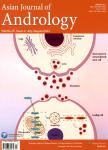Expression and localization of Smadl, Smad2 and Smad4 proteins in rat testis during postnatal development
Expression and localization of Smadl, Smad2 and Smad4 proteins in rat testis during postnatal developmentEnglish Full Text作者机构:DepartmentofHistologyandEmbryology DepartmentofBiochemistryandMolecularBiology DepartmentofOralHistologyandPathologySchoolofDentistryFourthMilitaryMedicalUniversityXi‘an710032China DepartmentofZoologyUniversityofHongKongHongKongHKSARChina
出 版 物:《Asian Journal of Andrology》 (亚洲男性学杂志(英文版))
年 卷 期:2003年第5卷第1期
页 面:51-55页
核心收录:
学科分类:1002[医学-临床医学] 1001[医学-基础医学(可授医学、理学学位)] 10[医学]
基 金:TheworkwassupportedbytheNationalScienceFoundationofChina(39870109)theMilitaryMedicalFoundation(98M106 01MA183)
主 题:TGF-β Smadl Smad2 Smad4 testis
摘 要:Aim: To study the expression and regulation of Smadl, Smad2 and Smad4 proteins (intracellular signaling molecules of transforming growth factor-β family) in rat testis during postnatal development. Methods: The whole testes were collected from SD rats aged 3, 7, 14, 28 and 90 (adult) days. The cellular localization and developmental changes were examined by immunohistochemistry ABC method with the glucose oxidase-DAB-nickel enhancement technique. Quantitative analysis of the immunostaining was made by the image analysis system. The Smads proteins coexistence in the adult rat testis was tested by the double immune staining for CD14-Smad4 and Smad2-Smad4. The protein expression of Smad during rat testicular development was examined by means of Western blots. Results: Smadl, Smad2 and Smad4 were present throughout testicular development. The immunostaining of Smadl and Smad2 were present in spermatogenic cells. A positive immunoreactivity was located at the cytoplasm, but the nucleus was negative. Smadl was immunolocalized at the d14, d28 and adult testes, while Smad2, at the d7, d14, d28 and adult testis. There was positive irnmunoreaction in the Sertoli cells and Leydig cells as well. The immunolocalization of Smad4 was exclusively at the cytoplasm of Leydig cells and the nuclei were negative throughout the testicular development. No expression was detected in the germ cells. The results of image and statistical analysis showed that generally the expression of Smadl, Smad2 and Smad4 in the testis tended to increase gradually with the growth of the rat. Conclusion: The present data provide direct evidences for the molecular mechanism of TGF-βaction in rat testes during postnatal development and spermatogenesis.



